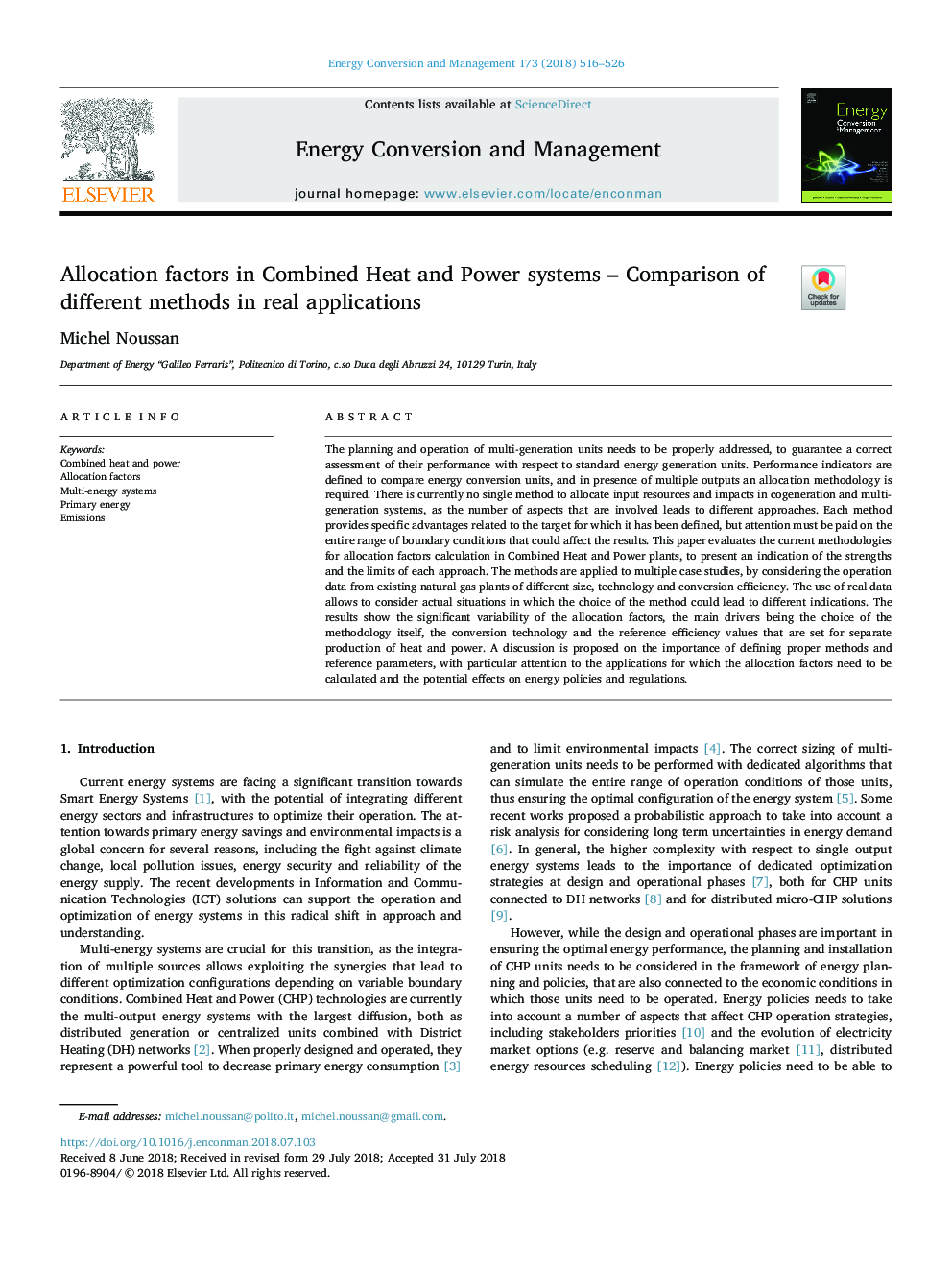| کد مقاله | کد نشریه | سال انتشار | مقاله انگلیسی | نسخه تمام متن |
|---|---|---|---|---|
| 7157773 | 1462789 | 2018 | 11 صفحه PDF | دانلود رایگان |
عنوان انگلیسی مقاله ISI
Allocation factors in Combined Heat and Power systems - Comparison of different methods in real applications
ترجمه فارسی عنوان
عوامل توزیع در سیستم های حرارت و برق ترکیبی - مقایسه روش های مختلف در کاربردهای واقعی
دانلود مقاله + سفارش ترجمه
دانلود مقاله ISI انگلیسی
رایگان برای ایرانیان
کلمات کلیدی
ترکیب گرما و قدرت، عوامل توزیع، سیستم های چندگانه، انرژی اولیه، انتشارات،
ترجمه چکیده
برنامه ریزی و عملیات واحدهای چند نسلی باید به طور صحیح مورد توجه قرار گیرد تا تضمین ارزیابی صحیح از عملکرد آنها با توجه به واحدهای تولید انرژی استاندارد باشد. شاخص های عملکرد برای مقایسه واحدهای تبدیل انرژی تعریف شده اند و در حضور خروجی های متعدد یک روش تخصیص الزامی است. در حال حاضر هیچ روش مناسبی برای اختصاص منابع ورودی و تاثیرات در سیستم های همگن و چند نسلی وجود ندارد، چرا که تعدادی از جنبه هایی که درگیر آن هستند، منجر به رویکردهای متفاوت می شوند. هر روش مزایای خاصی را در ارتباط با هدف مشخص می کند که در آن تعریف شده است، اما باید توجه کرد که در کل محدوده مرزی که می تواند بر نتایج تاثیر بگذارد، پرداخت شود. در این مقاله، روشهای جاری برای محاسبه فاکتورهای تخصیص در نیروگاههای حرارتی و برقی مشترک، به منظور نشان دادن نقاط قوت و محدودیت هر رویکرد ارزیابی شده است. این روش ها در مورد مطالعات متعدد مورد استفاده قرار می گیرند، با توجه به داده های عملیاتی از گیاهان طبیعی موجود در اندازه های مختلف، تکنولوژی و بهره وری تبدیل. استفاده از داده های واقعی اجازه می دهد تا شرایط واقعی را در نظر بگیریم که در آن انتخاب روش می تواند به نشانه های مختلف منجر شود. نتایج نشان می دهد که متغیرهای قابل توجهی از عوامل تخصیص، رانندگان اصلی انتخاب روش خود، تکنولوژی تبدیل و مقادیر کارایی مرجع است که برای تولید جداگانه از گرما و قدرت تنظیم شده است. بحث در مورد اهمیت تعیین روش های مناسب و پارامترهای مرجع، با توجه ویژه به برنامه های کاربردی که فاکتور های تخصیص باید محاسبه شود و اثرات بالقوه بر سیاست ها و مقررات انرژی، ارائه شود، ارائه می شود.
موضوعات مرتبط
مهندسی و علوم پایه
مهندسی انرژی
انرژی (عمومی)
چکیده انگلیسی
The planning and operation of multi-generation units needs to be properly addressed, to guarantee a correct assessment of their performance with respect to standard energy generation units. Performance indicators are defined to compare energy conversion units, and in presence of multiple outputs an allocation methodology is required. There is currently no single method to allocate input resources and impacts in cogeneration and multi-generation systems, as the number of aspects that are involved leads to different approaches. Each method provides specific advantages related to the target for which it has been defined, but attention must be paid on the entire range of boundary conditions that could affect the results. This paper evaluates the current methodologies for allocation factors calculation in Combined Heat and Power plants, to present an indication of the strengths and the limits of each approach. The methods are applied to multiple case studies, by considering the operation data from existing natural gas plants of different size, technology and conversion efficiency. The use of real data allows to consider actual situations in which the choice of the method could lead to different indications. The results show the significant variability of the allocation factors, the main drivers being the choice of the methodology itself, the conversion technology and the reference efficiency values that are set for separate production of heat and power. A discussion is proposed on the importance of defining proper methods and reference parameters, with particular attention to the applications for which the allocation factors need to be calculated and the potential effects on energy policies and regulations.
ناشر
Database: Elsevier - ScienceDirect (ساینس دایرکت)
Journal: Energy Conversion and Management - Volume 173, 1 October 2018, Pages 516-526
Journal: Energy Conversion and Management - Volume 173, 1 October 2018, Pages 516-526
نویسندگان
Michel Noussan,
